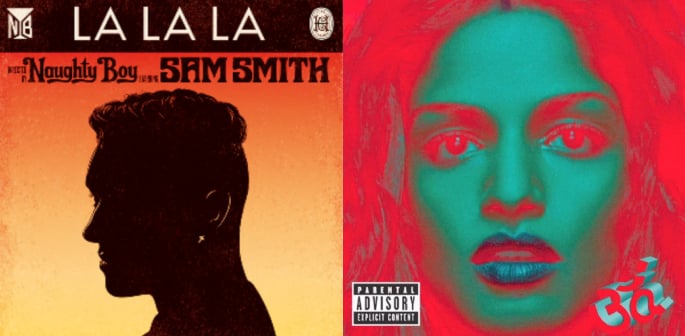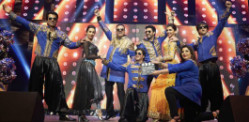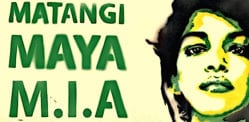It incorporates violins and an Indian fusion of sounds.
In British pop songs, Indian and Pakistani influences are evident, predominantly in the use of instruments and the adoption of lyrics from Indian movies.
Many of these songs have gained success and recognition for their innovation, though some have remained under the radar and are not as widely recognised.
While British music often features influences from R&B, Hip-hop, and Electronic genres, South Asian influences are less common.
Below is a list of British pop songs that incorporate South Asian elements.
‘La La La’ by Naughty Boy & Sam Smith

In 2013, a song that climbed to the pinnacle of the UK charts emerged as a collaboration between Naughty Boy and Sam Smith.
This track unfolds the poignant narrative of an abused deaf boy on the run from his adversities, discovering that he can fend off his demons through the power of his voice.
Despite its light and catchy rhythm and tempo, the song’s essence is far from cheerful, delving deep into the realms of emotional abuse.
Shahid Khan, known professionally as Naughty Boy intricately weaves synth piano and mallets with a mid-tempo drum ‘n’ bass rhythm, perfectly complementing Sam Smith’s soulful vocal style.
The song does more than narrate a story; Shahid also embeds his traumas from past failed relationships into the music.
He reflects, “…She was somebody I neglected while I was trying to find me. When I found me, she found it best to neglect me,” revealing a layer of personal vulnerability.
A distinct Indian influence is perceptible in parts of the lyrics, introducing a unique blend of cultures.
The song begins with a slow, mellow tone, setting a stark contrast with the higher-register Indian singing that follows, imbued with a playful essence that contrasts sharply with the sorrowful undertone of Sam Smith’s delivery.
The lyrics, “I find a way to block it,” echo the boy’s desperate search for an escape from his cyclic struggles, viewing his world through the naive eyes of youth.
His action of covering his ears, a childlike gesture, alongside the juxtaposition of turning up the volume while declaring “Enough is enough,” illustrates a tumultuous inner conflict, a battle between succumbing to negativity and the desire for liberation.
This confusion, coupled with the temptation of negativity, highlights the boy’s reliance on his heart rather than logic to navigate through challenging situations.
The Indian lyrics, repeated and looped in certain parts of the song, reinforce the theme of repetition and the cyclical nature of the boy’s plight.
Through this musical masterpiece, Naughty Boy and Sam Smith not only share a compelling story but also bridge diverse musical traditions, creating a rich tapestry of sound and emotion that resonates with listeners worldwide.
‘Bad Girls’ by M.I.A.

This song stands out as a mid-tempo dance-pop anthem, enriched with hip-hop, R&B, and distinct Indian influences, weaving together elements of Middle Eastern and Indian hooks.
Its structure is a vibrant mix of synths, syncopated drums, and a rhythm that’s impossible not to get caught up in.
Rolling Stone hailed “Bad Girls” as the most infectious track the artist has released since the groundbreaking “Paper Planes” from Kala in 2007.
The song’s instrumentation is a playful arrangement of bleeps, underpinning themes of sexual empowerment and feminism.
Lyrics like “Live fast, die young, bad girls do it well” and “My chain hits my chest when I’m banging on the radio” are delivered with an almost chant-like fervour.
Targeted at a female audience, the song’s tone verges on instructional, urging listeners to embrace a daring lifestyle.
This ethos is visually echoed in the music video’s thrilling car chases, symbolising the song’s embrace of speed and risk.
“Bad Girls” is a bold retort to male oppression, celebrating female audacity and competition.
The line “As the chain hits my chest, when I’m banging on the dance floor” flaunts a sense of wealth and empowerment, while the recurring Indian instrumental hooks complement the vocals, adding a layer of cultural richness.
The lyrics “steam on the window” and “gonna have you trembling” hint at erotic undertones, suggesting that the depicted car ride transcends mere transportation, hinting at a more dominant and sensual experience.
The invitation to “Pull me closer” challenges traditional courtship roles, encouraging men to approach if they dare.
Overall, the song portrays a character who revels in her own power and influence, using it not just to captivate but to challenge societal norms, all while “coming in the Cherokee,” symbolising her unapologetic boldness and autonomy.
‘Flower’ by Zayn

“Flower” is a captivating song performed in Urdu, the native language of the singer’s father, embodying a profound sense of pride in his heritage.
Malik shared with The Fader, “I’m just following my religion and doing all the normal things that everybody else does. I’m not trying to influence or make a religious statement. I am me, just doing me.”
In an article for The Rolling Stone, Malik reflected on his relationship with his father: “I was telling Malay about how important it was for me to earn his approval.
“My dad’s a hard worker with strong values. He wanted the best for me, and I wanted to make him proud… to show him, and everyone else, that I could succeed.”
The song begins with an eerie tone, which quickly transitions to gentle guitar music set against a light, atmospheric backdrop.
The contrast between the bright guitar sounds and Malik’s soothing, qawwali-inspired singing creates a unique auditory experience.
The song features riffs on a minor scale, adding to its beauty and therapeutic effect.
The singing, characterised by an echoing and faded quality, starts quietly and crescendos throughout the song, blending beautifully with the guitar in both higher and lower registers, allowing each element to shine independently.
Unlike his other work, which often features more upbeat instrumentals, “Flower” stands out for its calm and serene delivery.
The lyrics are rich with symbolism, hinting at a desperate search for love, to the extent of taking it if not found organically.
Love is likened to a flower, requiring nurture and care to flourish, reflecting the singer’s impatience and possibly other underlying traumas, with love seen as the only remedy.
Another layer of interpretation suggests the song might be about paternal love, highlighting how parents share in their child’s sadness and grief.
By offering their heart, they protect and support their child through life’s challenges, embodying the song’s deeper message of love and protection.
‘I’m You’ by Leona Lewis

Leona Lewis, the winner of the third series of The X Factor, rose to fame and has since worked with a diverse range of writers and producers, showcasing the variety in her music.
Her repertoire primarily blends R&B with pop ballads, yet the song ‘I’m You’ distinctly incorporates Indian influences.
Throughout her music career, Lewis has faced criticism for a perceived lack of innovation and personality.
‘I’m You’ might be seen as a response to these critiques. As of December 2012, Lewis had sold 28 million records worldwide.
Despite criticisms that she produces music primarily for commercial reasons, there’s no denying her extensive vocal range and the goosebump-inducing quality of her technique.
The song begins with a sitar in the introduction, accompanied by drum ‘n’ bass, with the sitar returning in the choruses.
This fusion, though arguably out of place, adds a unique layer to the track.
The lyrics serenade a lover, with Lewis’s singing remaining calm throughout; she employs a forte at times but does not use a belting technique.
Lewis also performs the backing vocals, creating a call-and-response effect towards the song’s end that enhances the melody.
Described as a comforting serenade, ‘I’m You’ metaphorically suggests that she and her lover are unified, embodying two halves of a whole.
The line “I am your heart” implies a deep emotional connection, suggesting mutual ownership and an intertwined love, which serves as a romantic expression of their bond.
‘Million Different Ways’ by Sugababes

“Million Different Ways” is a track from the album “Three,” released in 2003.
The Sugababes competed with groups like the Spice Girls and B*Witched in the music market. However, they offered something distinct as a trio, particularly with their elaborate stage choreography.
R&B heavily influences their music and, in some instances, indie rock, allowing the Sugababes to conquer dance floors in clubs with an edgy style.
The song features a hook with a sitar that is repeated several times.
In terms of vocals, the members of the girl group take turns singing the verses and come together for the chorus, creating an upbeat dance track with a simplistic melody.
The verses are slower than the chorus, providing a dynamic contrast.
The Sugababes share the song’s lyrics, with the first singer using a lower register, the chorus in a mid-register, and the last verse sung in a higher register.
Despite this, the style of singing remains consistent, characterised by their British accents. This contrasts with groups like Little Mix, where each member’s voice has distinct characteristics, such as sounding girly or sassy.
In “Million Different Ways,” the differences in vocal characteristics are less pronounced.
The lyrics are quite repetitive, focusing on the catchy melody rather than delivering an expansive ballad.
The song explores the theme of love, suggesting that once someone is in love, there are countless ways to express it through care, gestures, words, quality time, and affection.
It emphasises the clarity that comes with love and the tailored ways to please a partner when one truly knows them.
The lyrics also highlight the singer’s open-mindedness, offering her lover space and freedom with the line, “Whatever you wanna do.”
‘Eastern Jam’ by Chase & Status

This electronic duo consists of Saul Milton (Chase) and Will Kennard (Status).
Throughout their career, they have collaborated with notable artists such as Cee Lo Green, Rihanna, Example, and Tinie Tempah.
In an interview with GRM, Status shared:
“We’re not that musically trained, even though Saul is a proficient guitarist.
“He probably wouldn’t claim to be classically trained. But I think what we both have, which is crucial for a DJ—since DJing isn’t a classical instrument—is a good ear.
“I believe DJing revolves around a basic understanding of timing, which, for whatever reason, came naturally to us.”
Chase added, “We released ‘More Than A Lot,’ and it featured a track called ‘Eastern Jam,’ which remains one of my favourite tunes that we’ve produced.
“Will was flying to Miami for a conference, but then he connected with someone, did something, and before you knew it, the song had been recorded.”
Jay Z showed interest in “Eastern Jam,” but he didn’t want to overstep regarding Snoop.
“Rihanna heard the album, liked several tunes on it, and then I received a phone call at 3 am from Jay Brown.
“He said, ‘Hey man, hold on one sec,’ and then Rihanna came on the line. I couldn’t believe it.
“Two days later, Will and I were in Studio AM Metropolis, surrounded by every significant producer and songwriter of the time, all there to work on Rihanna’s album, and they were blasting ‘Eastern Jam!'”
Upon the song’s release, they faced competition from Rita Ora, who collaborated with Drake on “RIP.”
The lyrics of the song are derived from the Bollywood movie Devdas.
At the beginning of the song, the vocals are subdued, creating a faded effect. As the song progresses, the vocals take on a synthetic, almost robotic quality, characteristic of electronic music.
Certain sections of the lyrics are repeated. The bass of the drums is in a lower register, contrasting with the vocals in a higher register.
A hallmark of electronic music and dubstep is the presence of a “drop,” which occurs several times throughout the song, each time increasing in intensity.
This is when the music reaches a climax followed by a sudden change in rhythm or instrumentation.
Surround sound is employed to enhance the listening experience.
When listened to with two speakers, left and right, or with headphones, elements of the sound, such as the vocals or instrumentation, can seem to come from different directions.
The song’s context in the movie Devdas is about a girl waiting for her lover to return from London, where he was studying.
She keeps a candle alight to symbolise her enduring, passionate love for him. “Extinguish” refers to the candle burning away, symbolizing the potential loss of hope or love.
‘Galvanize’ by The Chemical Brothers

“Galvanize” features a sample of the snaking string part from “Hadi Kedba Bayna,” a song by Moroccan singer Najat Aatabou.
This track earned them a Grammy for Best Dance Recording in 2006. Additionally, the song includes a string sample from Najat Aatabou’s “Just Tell Me The Truth.”
The album “Push The Button” was awarded a Grammy for Best Electronic/Dance Album in 2006.
Tom Rowlands of The Chemical Brothers remarked, “Q-tip would only sing into a golden microphone. Not silver, not bronze. It practically came with its security guard.
“But I’m sure it gave his ‘Galvanize’ vocal that extra bit of punch,” according to Song Facts.
The song was featured during the entrance at the 2012 London Summer Olympics opening ceremony and takes full advantage of surround sound.
It incorporates violins and an Indian fusion of sounds, along with a dynamic range from piano (soft) to forte (loud), particularly distinguishing the verses from the louder chorus.
“Galvanize” also includes the use of ululation, otherwise known as Zaghrouta. The narrative follows a young group of boys who wear makeup to forge a sense of identity.
They encounter an older group of boys, leading to immediate conflict. Sneaking into a dance club, the climax unfolds as the boys join the dance floor’s centre, showcasing the other dancers.
“Galvanize” is an empowering song that symbolises resistance against the system and the importance of originality.
However, the story concludes with defeat as the police arrest the boys.
The song reflects the struggles of life, offering a message of freedom and escape from indifference.
It emphasises the challenge boys face in fitting in, advocating for intelligence and resilience in the face of negativity.
The inclusion of South Asian instruments, lyrics, and hooks in British songs is a testament to the diversity of cultures and musical influences.
Pop music, being the most mainstream genre, often overshadows less popular genres, leaving some cultural contributions unacknowledged.
This calls for a deeper exploration of South Asian samples in hip-hop music.





























































